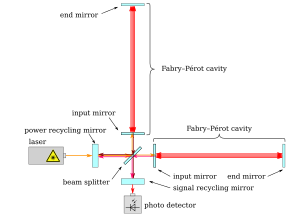LIGO facts for kids
The Laser Interferometer Gravitational-Wave Observatory (LIGO) is a large-scale physics observatory which detects cosmic gravitational waves. They were first funded by the National Science Foundation (NSF) and were conceived, built and are operated by Caltech and MIT. The NSF has funded improvements for LIGO to increase sensitivity, which allowed them to make the first detection of gravitational waves. LIGO is the largest and most ambitious project ever funded by the NSF.
Images for kids
-
Detector noise curves for Initial and Advanced LIGO as a function of frequency. They lie above the bands for space-borne detectors like the evolved Laser Interferometer Space Antenna (eLISA) and pulsar timing arrays such as the European Pulsar Timing Array (EPTA). The characteristic strains of potential astrophysical sources are also shown. To be detectable the characteristic strain of a signal must be above the noise curve. These frequencies that aLIGO can detect are in the range of human hearing.
-
Western leg of LIGO interferometer on Hanford Reservation
-
Northern leg (x-arm) of LIGO interferometer on Hanford Reservation
See also
 In Spanish: LIGO para niños
In Spanish: LIGO para niños









